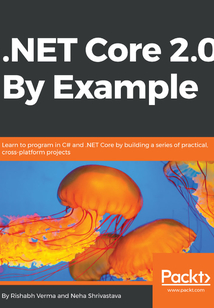舉報 

會員
.NET Core 2.0 By Example
Ifyouareadeveloperorarchitectandwanttolearnhowtobuildcross-platformsolutionsusingMicrosoft.NETCore,thisbookisforyou.Itisassumedthatyouhavesomeknowledgeofthe.NETFramework,OOP,andC#(orasimilarprogramminglanguage).
目錄(192章)
倒序
- coverpage
- Title Page
- Packt Upsell
- Why subscribe?
- PacktPub.com
- Contributors
- About the authors
- About the reviewer
- Packt is searching for authors like you
- Preface
- Who this book is for
- What this book covers
- To get the most out of this book
- Download the example code files
- Download the color images
- Conventions used
- Get in touch
- Reviews
- Getting Started
- Downloading required tools for Windows and Linux
- Downloads for Windows
- Downloads for Linux
- Installing .NET Core 2.0 and tools (Windows)
- Installing Visual Studio 2017 version 15.3
- Installing Visual Studio Code
- Setting up an Ubuntu Linux VM
- Ubuntu setup using Hyper-V
- Installing .NET Core 2.0 and tools (Linux)
- Creating simple running code
- Creating an application in Windows through Visual Studio 2017 version 15.3
- Creating application in Windows through Visual Studio Code
- F# primer
- Comments
- Data types
- Variable declaration
- Operators
- Arithmetic operators
- Comparison operators
- Boolean operators
- Bitwise operators
- Decision-making statements
- if statements
- Loop statements
- F# functions
- Calling a function
- File sequence
- Basic input/output syntax
- Summary
- Native Libraries in .NET Core
- Introduction to ncurses
- Interop with existing native and Mono libraries
- Platform Invoke (P/Invoke)
- DLLImport attribute
- Interop with existing native libraries with example
- When not to use P/Invoke
- Building a sample native library (C++)
- A sample application to implement new library and ncurses
- Summary
- Building Our First .NET Core Game – Tic-Tac-Toe
- Anatomy of an ASP.NET Core 2.0 application
- Tic-Tac-Toe
- Requirement specifications
- Designing the game
- SignalR
- SignalR transport mechanisms
- SignalR Core
- Solution
- Project setup
- Coding the game
- Game demo
- Summary
- Let's Chat Web Application
- Let's Chat web app requirement specifications
- Let's Chat web app – high-level design
- Project setup
- Authentication
- Windows authentication
- Forms authentication
- Token-based authentication
- Authorization
- Simple authorization
- Role-based authorization
- Claims-based authorization
- Middleware
- Dependency Injection
- How do you write custom middleware?
- Configuration
- Logging
- Summary
- Developing the Let's Chat Web Application
- ASP.NET Core 2.0 fundamentals
- Quick lap around MVC
- Routing
- Model binding
- Validation
- Filters
- Controllers
- Error handling
- Implementing authentication through Facebook
- Summary
- Testing and Deploying – The Let's Chat Web Application
- Chat hub module
- Razor primer
- Tag Helpers
- Views
- Razor pages
- Coding the Chat hub module
- Testing overview
- Unit testing
- Testing using xUnit
- Live Unit Testing
- Introduction to containers
- Docker
- Bot 101
- Summary
- To the Cloud
- Introduction to the cloud
- Types of cloud
- Getting started with Azure
- Creating a VM in Azure
- Automating using PowerShell
- Publishing a web app in Azure
- Azure App Services
- Publishing the web app
- Publishing profiles
- App Service features
- DEPLOYMENT
- SETTINGS
- DEVELOPMENT TOOLS
- API
- MONITORING
- SUPPORT + TROUBLESHOOTING
- Cloud storage
- Summary
- Movie Booking Web App
- Introducing Entity Framework
- Presenting Entity Framework Core
- Getting started with Entity Framework Core
- Movie booking app requirements
- Designing the movie booking app
- Coding the movie booking app
- Deploying the movie booking app
- Monitoring the movie booking app
- Application Insights
- Summary
- Microservices with .NET Core
- Introduction to microservices
- A traditional service
- Microservices
- Handy things to know
- General tips
- Performance tips
- Azure tips
- Introducing Blazor
- What's coming in .NET Core 2.1
- Summary
- Functional Programming with F#
- Introduction to functional programming
- Functional programming features
- Higher-order functions (HOF)
- Purity
- Recursion
- Currying
- Closure
- Function composition
- Introduction to F#
- Basics of classes
- Constructor of a class
- A let and do binding
- Generic type parameters
- Properties
- Static and instance properties
- Abstract properties
- Inheritance and casts
- Virtual methods and overrides
- Constructors and inheritance
- Functions and lambda expressions
- Handling data – tuples lists record types and data manipulation
- List
- Record type
- Object-oriented programming in F#
- Exception handling
- Data access layer with F#
- CSV HTML JSON and XML data
- Providers
- Data access tools
- SQL data access
- Web data access
- Querying SQL vNext with F#
- Summary
- Other Books You May Enjoy
- Leave a review - let other readers know what you think 更新時間:2021-06-24 18:31:30
推薦閱讀
- MacTalk 跨越邊界
- 軟件工程基礎教程
- GitLab CI/CD 從入門到實戰
- Swift權威指南
- 全棧Monorepo開發實戰(Vue 3+Fastify+Deno+pnpm)
- 區塊鏈核心算法解析
- 鳳凰項目:一個IT運維的傳奇故事
- 項目實踐精解:基于EJB 3.0和Web Services的Java應用開發
- 軟件架構指標:度量軟件系統的性能和架構質量
- 軟件開發的201個原則
- TensorFlow+Android經典模型從理論到實戰(微課視頻版)
- 深入淺出Spring Boot 3.x
- Google Android開發入門與實戰
- 軟件安全開發
- 分布式高可用算法
- 軟件之美
- 大數據測試技術與實踐
- Android移動應用開發
- 游戲概念設計理念與案例解析
- 解構領域驅動設計
- 案例解說MATLAB典型控制應用
- DevOps開發運維訓練營
- Android程序開發范例寶典
- 有限元基礎與COMSOL案例分析
- Linux高級程序設計(第三版)
- 加速:高效能軟件交付之道
- 微信公眾平臺應用開發實踐
- containerd原理剖析與實戰
- 極客與團隊
- 善用佳軟:高效能人士的軟件應用之道

